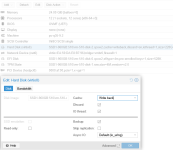Hi,
my background is 20+ years Linux and Windows experience, working for an SMB, virtualization was done with VMware as long as is was sanely priced. Since it is no more, we (as many others) are looking for alternatives and I really like Proxmox for the openness and simplicity. I want this to be our migration target platform but I need to make sure performance is mostly on par with the former solution on the hardware we just bought 1 year ago. (3 node cluster, all-flash Alletra SAN storage over iSCSI with 25 GBE connections). I was very excited to see the new snapshot feature with thick provisioned LVM in Proxmox 9, then did some testing. Unfortunately I hit a wall, and it is not related to the new feature.
Since we have a majority of Windows VMs, some of which host the ERP databases that need to be fast, I tested with the tool recommended by the vendor, Atto benchmark, specifically with small block sizes from 4k to 64k and max. queue depth=4. I used to get 20k IOPS in a Windows guest on ESXi, but in Proxmox it was just 8k. Then I retested on a local ssd storage in a test machine, getting 12k IOPS, so it wasn't the SAN / switches, NICs. (Yes, I did use VirtIO SCSI single and io_uring for the disks.)
To be able to see the virtualization overhead and possible hardware limitation, I did a comparable test with fio directly on the host and got great numbers, 470k IOPS with 4k blocks. I did the same in a Debian Trixie VM, also getting just above 400k IOPS. I thought I had some error in my fio job definition, but then I did the same test with fio on a Windows VM again. I got almost the same values as with Atto, between 9k and 12k IOPS. Translated to throughput, this is 40MB/s in Windows (at 4k random q=4), compared to 1500MB/s in Linux with the same fio job! Again, I used VirtIO drivers in Windows and the VM was on the same physical SSD as the Linux one. Storage was on a simple LVM, the one the installer creates "behind" the Proxmox partition on the install M.2 SSD. No ZFS, no Ceph, just a huge difference between Windows and Linux guests that I have no explanation for.
To not just rely on synthetic benchmarks I also did a HammerDB run against a MS SQL database running on VMware vs. Proxmox and the results are not as divergent but still point in the same direction. (I guess due to this test being more CPU bound and not only storage.)
Please tell me I overlooked something. I do not really like the prospect of going the Hyper-V route...
my background is 20+ years Linux and Windows experience, working for an SMB, virtualization was done with VMware as long as is was sanely priced. Since it is no more, we (as many others) are looking for alternatives and I really like Proxmox for the openness and simplicity. I want this to be our migration target platform but I need to make sure performance is mostly on par with the former solution on the hardware we just bought 1 year ago. (3 node cluster, all-flash Alletra SAN storage over iSCSI with 25 GBE connections). I was very excited to see the new snapshot feature with thick provisioned LVM in Proxmox 9, then did some testing. Unfortunately I hit a wall, and it is not related to the new feature.
Since we have a majority of Windows VMs, some of which host the ERP databases that need to be fast, I tested with the tool recommended by the vendor, Atto benchmark, specifically with small block sizes from 4k to 64k and max. queue depth=4. I used to get 20k IOPS in a Windows guest on ESXi, but in Proxmox it was just 8k. Then I retested on a local ssd storage in a test machine, getting 12k IOPS, so it wasn't the SAN / switches, NICs. (Yes, I did use VirtIO SCSI single and io_uring for the disks.)
To be able to see the virtualization overhead and possible hardware limitation, I did a comparable test with fio directly on the host and got great numbers, 470k IOPS with 4k blocks. I did the same in a Debian Trixie VM, also getting just above 400k IOPS. I thought I had some error in my fio job definition, but then I did the same test with fio on a Windows VM again. I got almost the same values as with Atto, between 9k and 12k IOPS. Translated to throughput, this is 40MB/s in Windows (at 4k random q=4), compared to 1500MB/s in Linux with the same fio job! Again, I used VirtIO drivers in Windows and the VM was on the same physical SSD as the Linux one. Storage was on a simple LVM, the one the installer creates "behind" the Proxmox partition on the install M.2 SSD. No ZFS, no Ceph, just a huge difference between Windows and Linux guests that I have no explanation for.
To not just rely on synthetic benchmarks I also did a HammerDB run against a MS SQL database running on VMware vs. Proxmox and the results are not as divergent but still point in the same direction. (I guess due to this test being more CPU bound and not only storage.)
Please tell me I overlooked something. I do not really like the prospect of going the Hyper-V route...
Last edited:


